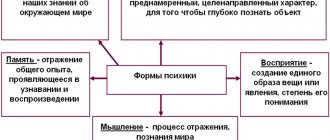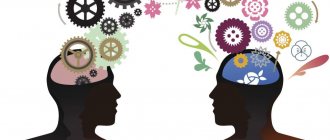Personality qualities are a distinctive set of traits inherent in a person, expressing the uniqueness of states, psychological processes, aspects of character and behavioral patterns in society or the natural environment. The qualities of a person’s personality are always personal. They have quantitative characteristics, as a result of which they are measured by degree, stage of development or level.
A personal set of traits is simultaneously characterized by stability (at the time of measurement) and dynamism, in other words, they remain in constant development (over the years of a person’s existence). Their production and transformation are determined by many conditions of a biological and social nature. Their appearance and further development are significantly influenced by the spirituality of the individual.
Definition of the concept
Since the phenomenon of personality is a subject of study not only in psychology, but also in other humanities, the term does not have an unambiguous definition. For a better understanding of what a person is, three main definitions will be given below.
Personality is a set of individual qualities of a person (thinking, will, and so on) that determine his behavior in society, speak about his values, life experience, and aspirations.
In other words, the psychological difference between one individual and another characterizes his personality.
A person can be defined as a subject of society with a set of roles (social and personal), certain habits and experiences.
This term also refers to a person who is completely responsible for all aspects of his life.
Family education
Personal characteristics, as we said above, are a whole complex of characteristics, including positive and negative qualities of a person. They appear from childhood, it’s no secret. As well as the disposition to certain types of activities.
Education plays a huge role in the development of personality. Now it has become fashionable to indulge children and turn a blind eye to such actions for which even twenty years ago the offspring would be punished. The result of such upbringing will be disastrous, because children need not only positive reinforcement, but also negative.
Surely, more than once you have seen a child scream at the top of his lungs, demanding something from his mother. And she gently coos over him, persuades him, or simply gives him what he wants. This is positive reinforcement of unwanted behavior. How will such a child grow up? He will become a good manipulator, accustomed to getting his way on demand. Therefore, it is important to put the child in his place in time, letting him understand that not everything required is fulfilled, and bad behavior leads to punishment.
The peculiarities of personal development lie in the fact that parents guide their child in the right direction, taking into account his inclinations and characteristics. If a child is obsessed with animals and declares that he wants to become a veterinarian, there is no need to dismiss him, citing an unconscious age. On the contrary, encourage your offspring’s desire, buy him interesting books on this topic, show him films. Over time, the child may abandon the conceived idea, continuing to search for himself, or perhaps establish himself in the chosen future field of activity.
Personality structure
To better understand the term, it is worth considering its structure.
The structure of personality can be understood as the interaction of its component parts (character, aspirations, will, abilities, emotions). These parts (components) characterize a person; they can be called her traits. To structure these personality-defining traits, the following levels are distinguished:
- lower,
- second,
- third,
- higher.
The lowest level is the mental characteristics of a person determined by gender, age, and innate qualities.
The second level involves individual characteristics depending on innate qualities and their development (memory, thinking, abilities, perception of the surrounding world).
The third level is formed throughout life and is associated with socialization. It defines individual experience (knowledge acquired throughout life, habits, skills).
The highest level reflects the worldview, inclinations, beliefs, character traits, the so-called personality orientation. The highest level is most dependent on the social environment in which the formation of personality occurs. Education has a strong influence on the formation of this level. This structure gives a generalized idea of personality. Each person is multifaceted and the differences between people at each level of the structure discussed above are determined by individual experience, beliefs, character, and knowledge. This versatility and individuality often becomes the reason why it is difficult to understand an opponent and avoid conflict situations.
To better understand others and yourself, you need to have an idea of personality characteristics, be aware and observant.
Moral qualities
Morality is the system of internal values of a person that determine his behavioral response, attitude towards the social environment, close people and himself.
A person’s system of internal norms is developed as a result of the influence of many factors: family relationships, personal experience, school environment, social relationships.
Morality can be racial, humanistic, religious-fanatical, nationalistic, which is determined by the values that were the basis for the formation of a person’s internal rules.
The moral formation of a child’s personality is determined by his perception of moral norms, knowledge of such norms, habits of behavioral reactions, and the internal position of the baby.
For the development of a child as a social creature, knowledge of behavioral norms is of paramount importance. The preschool age of the baby is characterized by the assimilation of social postulates of behavior through interaction with the environment (relatives, peers, teachers).
The assimilation of norms, first of all, involves the child’s gradual understanding and comprehension of their role, as well as the development of behavioral habits through interaction with society. A habit reflects an emotionally felt stimulating force - the child has to act, violating normal behavior, which creates a feeling of discomfort in the baby. In addition, the assimilation of norms presupposes that the child absorbs a certain emotional attitude towards the norms.
Important personality qualities, such as tact, correctness, respect, careful attitude towards heritage, nature - this is the basis on which the successful coexistence of a person in society is built.
Among the primary moral qualities are the following:
– philanthropy (selfless help to people, kindness);
– loyalty (this trait has two directions: towards oneself, that is, following one’s own principles, ideals, and outside, which implies loyalty to the Fatherland);
- respect;
– selflessness (actions without personal gain);
– spirituality (a characteristic that includes moral aspects and religiosity, which exalts the human spirit).
Main characteristics
In psychology, personality characteristics are understood as those mental phenomena through which an individual manifests himself in communication with others and in everyday activities. The following main personality characteristics are distinguished:
- capabilities,
- will,
- temperament,
- character,
- emotions,
- motivation.
Capabilities
When it comes to a person’s successes and achievements (for example, studying at school), abilities are considered to be the criterion for assessing this success.
Abilities can be called properties of the soul, uniting all mental processes and states of a person. They also mean the totality of all the skills of an individual, thanks to which he successfully performs certain actions. Simply put, ability is both the ability to do something well, for example, to draw, and to experience strong feelings, for example, love or compassion.
Abilities are divided into:
- complex and simple
- practical and theoretical,
- educational and creative,
- general and special,
- communicative and subject-active.
Complex and simple abilities
The simplest include innate abilities based on the activity of the senses and elementary motor activity. For example, the ability to distinguish colors, sounds, walk, sit, and so on.
Complex abilities are understood as skills related to human culture (painting pictures, the ability to solve difficult problems in physics, etc.). These are not innate abilities; they are socially conditioned.
What is it for?
Everyone can try to make their own psycho-portrait or study the behavior of a loved one. However, to obtain accurate and most reliable data, it is better to seek help from a specialist. To fully determine your personality characteristics, sign up for my personal consultation. Having such data, you can find the most suitable occupation, hobby, find out the degree of your openness and sociability, identify goals, and increase self-esteem.
Practical and theoretical abilities
Practical abilities are understood as the ability of an individual to pose and solve problems that require action in certain situations.
Theoretical abilities determine abstract and logical thinking, the ability to solve theoretical problems.
Academic and creative abilities
Learning abilities mean how well a person learns new things, acquires knowledge, and acquires skills.
Creative abilities determine an individual’s ability to generate new ideas and produce spiritual and material values.
General and special abilities
General abilities are understood as those abilities that every person has (general mental, motor). But they are developed differently for everyone. And success in certain areas depends on this.
Special abilities can be defined as specific abilities that not every individual has. As a rule, they require innate abilities. This could be musical, acting or literary abilities.
Personal and psychological characteristics
These properties include a person's temperament. Let's remember what one of the greatest physiologists on the planet, Ivan Petrovich Pavlov, says about this. He identifies four types of temperament, which are characterized as follows:
- Strong, agile, unbalanced. We are talking about choleric. The main psychological feature of this type is that the processes of excitation prevail over the processes of inhibition.
- Strong, agile, balanced - sanguine. It is believed that this is the best human temperament, because the processes of inhibition and excitation are in balance.
- Strong, inert, balanced - the phlegmatic type. Inhibition processes prevail over excitation processes.
- Weak, unbalanced - melancholic. Such people have weak processes of excitation and inhibition.
Will
Will is what allows an individual to control his actions and psyche. This is conscious control over one’s behavior, a conscious influence on the surrounding reality.
The following factors can be called signs of will:
- making informed decisions,
- achieving your goals, overcoming difficulties on the way to them,
- self-restraint, when in order to achieve a goal an individual deprives himself of something that may seem attractive to him,
- a clear action plan,
- lack of emotional satisfaction from solving the task,
- moral satisfaction associated with achieving and overcoming oneself.
Will is a person’s main assistant in achieving his goals, the quality that helps him develop and grow as a person. It is the will that helps a person overcome life’s difficulties, even when it seems that the goal is unattainable.
It all starts from childhood
Childhood is a wonderful time of carelessness and security. It seems to the child that the world around him is beautiful, huge and simply beckons. A growing child begins to explore it in childhood, when he is not aware of himself, but the development of his personality is already beginning.
If we talk about the behavior of a very young child, he already has his own characteristics and basic qualities. A child’s personal characteristics are inherent in him from infancy. It is not for nothing that parents who have two or more children, when making comparative characteristics, note for themselves the different behavior patterns of their offspring. And very often you can hear stories from friends in which they say that their children are completely different, although they were born by the same parents. One, from childhood, was distinguished by stubbornness, willpower and mobility. He grew up to be a real spirit, he does everything in life by running, but efficiently. And the second one grew up “foul-mouthed”, modest and inert. As an adult, he remained as infantile as in childhood.
The personal characteristics of a child depend on genetics, someone will say. Actually this is not true. Genetics can bring surprises, and successful parents give birth to real brats. Parents are beginning to find out where this comes from. And they remember that grandfather was too modest and unable to show willpower in any matter.
Personal characteristics are influenced by the following factors:
- Genetics.
- Family education.
- Environment.
And if we have already talked about the first factor, then the next two are worth considering more carefully.
Temperament
Temperament is those properties of the psyche that are responsible for its processes and human states.
The following main types of temperament, defined by Hippocrates, are distinguished:
- melancholic,
- choleric,
- phlegmatic,
- sanguine.
A melancholic person is characterized by a tense inner life. People with this temperament are usually gloomy, vulnerable, and have a high level of anxiety. They are restrained in communication, get tired quickly, and give in to difficulties.
Cholerics are quick-tempered, impulsive people, persistent. They have difficulty restraining their emotions, but quickly calm down if they get their way. Such people are true to their interests and aspirations.
Phlegmatic people are efficient and patient, they know how to control themselves perfectly. These are cold-blooded people who are difficult to disturb, but if this happens, it is difficult for them to calm down. Those with a phlegmatic temperament have difficulty adapting to new things and do not easily get rid of old habits.
Sanguine people are cheerful, optimistic, sociable people who love to joke. They are open to new things and easily adapt to changes, they are disciplined in their work and are able to keep their emotions in check.
This is a general and incomplete classification that gives general ideas about temperament.
You need to understand that a person can combine traits of different temperaments and that these types are not often found in their pure form.
Character
In psychology, character is understood as the way a person interacts with other people and the world. It is formed depending on the social conditions in which the individual is located and raised.
Character is manifested in the reaction to the actions of other people, in the manners of the person himself. Many character traits can be grouped into three groups:
- strong-willed,
- business,
- communicative,
- motivational,
- instrumental.
As it is not difficult to guess, strong-willed character traits determine a person’s will and its accompanying qualities (perseverance, determination, compliance).
Business traits are how an individual behaves during work (conscientiousness, laziness, responsibility, tendency to procrastinate).
Communication traits determine how contactable and sociable a person is, how he communicates with others (openness, kindness, politeness, rudeness, isolation).
Motivational traits mean those qualities that encourage action, directing it. Instrumental traits give a certain style to human behavior.
Emotions
Emotions in psychology are defined as individual experiences that arise when vital needs are satisfied (dissatisfied). They may be pleasant or not.
A person is capable of experiencing a variety of emotions, but the main ones include the following:
- the simplest emotions
- mood,
- affects,
- feelings.
The simplest emotions, their manifestation, are associated with the satisfaction of physiological needs.
Mood is a set of emotions that can describe the state of an individual at a certain moment.
Affects can be called strong short-term emotions that have...
By feelings, psychologists understand an individual’s experiences caused by a certain object.
Emotionally, people are very different from each other. These differences consist of different intensity and direction, and the duration of the experience of emotions.
Emotions influence decision-making and specific actions. This is why it is important to control your feelings.
Teenagers
The most complex human specimens. The basis of the personal characteristics of adolescents is moral immaturity, a heightened sense of justice and emotional instability. A teenager is no longer a child, but not yet an adult, although he very diligently pretends to be this role. His hormonal levels change, external changes occur, and his internal balance is disrupted. Yesterday's beautiful little girl suddenly discovers the appearance of pimples and greasy skin. For an adult who is confident in himself, this is not a problem. But for a teenager it’s a whole complex. Most of them are unsure of themselves; under their aggressive behavior there is a lot of fears and complexes hidden.
What should others do when communicating with such a “hedgehog”? Keep in mind that at this stage of development, personal characteristics are a changing factor. And correct the teenager’s unwanted behavior only with the help of positivity and positive reinforcement.
Cholerics
Personal characteristics of a person with a choleric type of higher nervous activity include the following emotional characteristics:
- Restlessness, because choleric people find it difficult to focus on one thing. They are capable of starting a business, but not finishing it.
- Impulsiveness - such people live by emotions. Under the influence of impulse, they commit the most unpredictable actions, for which they blame themselves.
- Rapid arousal, which is due to temperament. They lose their temper very easily and are not shy about showing emotions. But the outbreak quickly fades away, and the choleric person becomes ashamed of the negative emotions shown.
- Burnout. Routine work is not for choleric people, nor are things that require maximum concentration. These people, due to their emotional and personal characteristics, quickly get tired and burn out.
Ears
Look at the pictures to see how to draw ears. The ear is located between the brow and nasal lines.
In the ¾ portrait the man is depicted with one ear, the other ear is “hidden”. Remember, the ear should be tilted towards the head.
Sanguines
If you or someone close to you has this type of GNI, then you are very lucky. The most sober and balanced people are sanguine people. Their main personal characteristics are balanced judgments and actions. The most pronounced qualities include:
- Practicality - representatives of this personality type know how to look forward. They are very practical in their actions, they calculate everything in advance.
- Patience is one of the best qualities of a sanguine person. At the moment of failure, he will not fold his “paws”, but will be patient, clench his teeth, get up from his knees and start all over again.
- Sobriety - we mentioned this above. A sanguine person does not panic like a choleric person. He is able to turn on “cold thinking” in the most emergency situations. In ordinary life, a sanguine person looks at the world without rose-colored glasses, soberly assessing his own abilities and capabilities.
Determination methods
To obtain the information of interest, researchers use various techniques:
- External observation. A purposeful technique that is necessary to obtain information about the manifestations of the psyche and behavior of the subject. Observation requires expenditure of funds, time, and preparation.
- Introspection or self-observation. The individual must independently observe his own mental manifestations in different situations. The information received cannot be considered adequate, but it is suitable for comparison with the opinions of others.
- Tests, questionnaires. Developed on the basis of a conversation between a psychologist and a subject. They allow one to determine temperament, motives, and inclinations towards a particular type of activity, and to identify factors influencing an individual’s behavior.
- Sociometry is psychological research used to study interpersonal relationships in various social groups between individuals.
- Experiment - the study of the characteristics of a person’s behavior depending on changes in environmental factors. Laboratory equipment may be used to conduct experiments.
- Interview, questionnaire. The specialist prepares a series of written or oral questions to obtain the information of interest.
Phlegmatic people
These people are difficult to move, they are inert and often go with the flow. The main personal characteristics are:
- Closedness. It does not manifest itself in such volumes as in the same melancholic person, but people with this type of GNI prefer to carry everything within themselves and once again not open up to others.
- Tendency to loneliness. Despite the outward friendliness of a phlegmatic person, the best company for him is his own person.
- Poor adaptability. For a phlegmatic person, a global life change will be a real tragedy. These people prefer predictability and stability.
Nose
How to draw a portrait of a person if you don’t learn how to draw one of the most difficult details, the nose. We do this step by step.
Step 1
We draw parallel lines - this is the width of the nose.
Step 2
The two lines end with the original “capsule”. This is a widening of the nose.
Step 3
We depict the nostrils.
Step 4
Shading for a chiaroscuro effect.
Step 5
To make the shadow look natural, we even it out a little.
Sources used:
- https://studopedia.ru/11_251651_psihologicheskie-harakteristiki-lichnosti.html
- https://srazu.pro/lichnost/kachestva-lichnosti-v-psixologii.html
- https://cosmeton.ru/karera/psihologicheskij-portret-lichnosti.html
Motivation
In general, there are two sides to human behavior that complement each other: incentive and regulation. The incentive side ensures the activation of behavior and its direction, and the regulatory side is responsible for how behavior develops under specific conditions.
Motivation is closely related to such phenomena as motivations, intentions, motives, needs, etc. In the narrowest sense, motivation can be defined as a set of reasons that explain human behavior. This concept is based on the term “motive”.
A motive is any internal physiological or psychological urge responsible for the activity and purposefulness of behavior. Motives can be conscious and unconscious, imaginary and really active, meaning-forming and motivating.
The following phenomena influence human motivation:
Need is a state of a person’s need for anything necessary for normal existence, as well as mental and physical development.
A stimulus is any internal or external factor, coupled with a motive, that controls behavior and directs it to achieve a specific goal.
Intention is a thought-out and consciously made decision that is consistent with the desire to do something.
Motivation is a person’s not fully conscious and vague (possibly) desire for something.
It is motivation that is the “fuel” of a person. Just as a car needs gasoline so that it can go further, a person needs motivation in order to strive for something, develop, and reach new heights. For example, you wanted to learn more about human psychology and personality traits, and this was the motivation for turning to this lesson. But what is great motivation for one may be absolute zero for another.
Knowledge about motivation, first of all, can be successfully used for yourself: think about what you want to achieve in life, make a list of your life goals. Not just what you would like to have, but exactly what makes your heart beat faster and makes you emotional. Imagine what you want as if you already have it. If you feel that it turns you on, then this is your motivation to act. We all experience periods of ups and downs in activity. And it is precisely in moments of decline that you need to remember what you should move forward for. Set a global goal, divide its achievement into intermediate stages and start taking action. Only the person who knows where he is going and takes steps towards it will reach his goal.
Also, knowledge about motivation can be used in communicating with people.
An excellent example would be a situation where you ask a person to fulfill some request (for friendship, for work, etc.). Naturally, in exchange for a service, a person wants to receive something for himself (as sad as it may be, most people are characterized by selfish interest, even if it manifests itself in some to a greater extent and in others to a lesser extent). Determine what a person needs; this will be a kind of hook that can hook him, his motivation. Show the person the benefits. If he sees that by meeting you halfway, he will be able to satisfy some essential need for him, then this will be an almost 100% guarantee that your interaction will be successful and effective.
You can learn about the features of motivation, its types and other interesting things from the next lesson of our training.
In addition to the above material, it is worth mentioning the process of personality development. After all, everything that we considered before is closely interconnected with this process, depends on it and at the same time influences it. The topic of personality development is very unique and voluminous for describing it as a small part of one lesson, but it cannot be ignored. And therefore we will touch on it only in general terms.
Melancholic people
The weakest type of temperament. Their personal characteristics are a set of unenviable characteristics, which include increased lethargy, inertia and complete unadaptability to life. But is this really so?
- Melancholic people are highly sensitive. The smallest remark can make them cry. But what is most interesting is that it is among melancholic people that there are the largest number of outstanding creative people. Due to their heightened sensitivity, they pick up on subtleties that other types would not even see.
- Perfectionists with increased feelings of guilt. Melancholic people love to bring their affairs to perfection. And if someone is dissatisfied with their work, then representatives of this type will not even think that the critic may simply be finding fault. They immediately withdraw into themselves, scolding themselves for not being diligent enough.
- Reduced performance. A large and noisy team leads melancholic people into a stupor. They need frequent breaks from work with time away from colleagues. In the company of people, this type of personality feels extremely uncomfortable. But alone with himself he is able to perform the most difficult work. That is why there are many talented programmers and creative people among melancholic people.
Structural aspect of personality
For a more complete understanding of what qualities characterize a person, it is worth highlighting the structure of individuality. Conventionally, we can imagine four levels:
- I. The level of temperament, including the characteristics of genetic predisposition, in particular the individual nervous system of a person.
- II. The level of individual mental processes, revealing features determined by the peculiarities of perception and imagination, memory and will, sensations and attention, thinking.
- III. A level that affects the experienced part of the personality, namely qualities in the field of knowledge, skills, abilities and habits.
- IV. The level of social orientation includes features that reflect the individual’s relationship to the outside world. They guide and regulate the psychological foundation of human behavior - these are interests and views, beliefs and social attitudes, moral principles.
The connecting link between all four levels are such individual qualities that characterize a person as needs and character, abilities and egocentrism, which together with the above levels form the personal shell of the individual.
Strong-willed traits of people
Adjusting behavioral factors associated with overcoming internal and external discomfort makes it possible to determine personal qualities: the level of effort and plans for taking actions, concentration in a given direction. Will manifests itself in the following properties:
- willpower - the level of effort to achieve the desired result;
- perseverance – the ability to mobilize to overcome troubles;
- endurance - the ability to limit feelings, thinking and actions.
Courage, self-control, commitment are the personal qualities of strong-willed people. They are classified into simple and complex acts. In a simple case, incentives to action flow into execution automatically. Complex acts are carried out on the basis of motivation, drawing up a plan and taking into account the consequences.
Correction methods
In order to influence the mental, practical activity of the individual, psychologists are constantly developing new techniques. Psychocorrection methods:
- Auto-trainings are trainings that use three ways to influence the functioning of the nervous system. The first is that in order for the subject to relax the muscles of the body, he must learn to control the rhythm of breathing. The second method is the presentation of sensory images. The third way is to pronounce programming words mentally or out loud.
- Group trainings. Their goal is to develop personal relationships between people and assist in communication.
Each method consists of several practices that have the same goal, but are carried out differently.
A psychological profile of a person is compiled to obtain an idea of a person, his capabilities, talents, and inclinations. Only an experienced psychologist can draw up a portrait using certain techniques.









